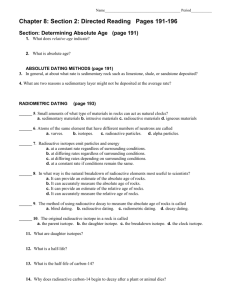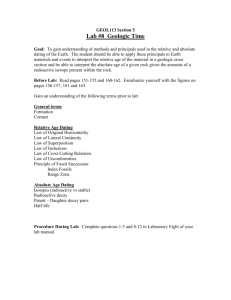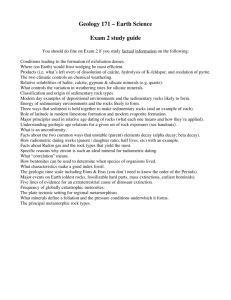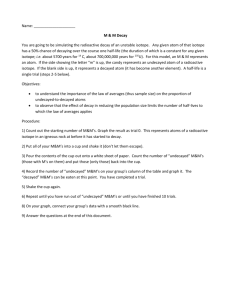half-life
advertisement
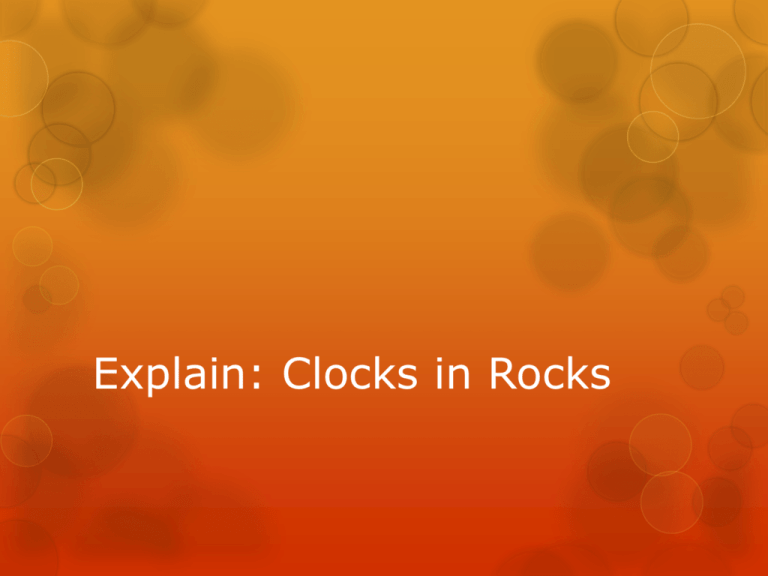
Explain: Clocks in Rocks Entry Task How do rock layers provide evidence of change across time? Order the layers from oldest to youngest (sketch and label the picture in your notebook) Explain: Clocks in Rocks Start a new header/thread “Clocks in Rocks” and date 11/8/2013. Learning Target: I can describe the process of radioactive decay and how radiometric dating techniques can be used to date rocks. Update your TOC – don’t forget the date! Explain: Clocks in Rocks Read the Introduction p. 288 We are going to do the process and procedure a bit out of order. P&P 3,4,5 first – class activity P&P 1,2,6-8 - individually Explain: Clocks in Rocks P&P 3,4,5: Half-life simulation Type of atom Trial # Parent 1 2 3 total Daugh 1 ter 2 3 total 0s 10s 20s 30s 40s 50s 60s Explain: Clocks in Rocks Complete P&P 1,2,6-8 Make sure you take notes on the reading. Write a summary of the reading (2 sentences) Complete R&C #1-4 p. 293-296 Read/Notes on “FYI: Changing Rates of Change” p. 294-295. Summary at the end! Entry Task Read Predator and Prey Process and Procedure p. 296-300. Radiometric Dating notes In the late 1800’s, scientists discovered that some minerals in rocks contain radioactive elements. Isotopes are atoms of the same element that contain different numbers of neutrons. This means that isotopes have the same atomic number (number of protons), but different atomic masses (number of protons and neutrons). The nuclei of some isotopes are unstable – they break down into isotopes of different elements which are more stable. Radiometric Dating notes Radioactive decay is the process by which the nucleus of an unstable atom emits particles of radiation to become a more stable isotope of a different element. Particles that are emitted can be alpha particles (He nucleus), beta particles (electrons) or gamma rays (energy) alpha decay – results in a new element beta capture - results in a new element (a proton becomes a neutron) beta decay - results in a new element (a neutron becomes a proton) Gamma decay – element doesn’t change, energy is released. 3 primary ways of decay alpha decay (Z ≥ 58) particle has 2 neutrons and 2 protons U238 Th234 92 protons 90 protons beta decay (n0 = p+ + e-) breakdown of neutron into an electron and a proton and loss of the electron to leave a proton (result is gain of one proton) K40 Ca40 19 protons 20 protons electron capture (e- + p+ = n0) capture of an electron by a proton and change of proton to neutron (result is loss of proton) K40 Ar40 19 protons 18 protons Radiometric Dating Notes The original element is called the parent element. When the parent element decays, the new element is called the daughter element. The half-life is the amount of time it takes for exactly half the parent atoms to decay to daughter atoms. Each radioactive element has a unique halflife. (the rate of decay is constant) Some half-lives are small (days – years), some are very large (millions to billions of years). predictable ratios at each half-life exponential decay (half always remains) exponential decay: never goes to zero exponential linear example: Uranium 238 decay to Lead 206 (stable) several steps (each has its own half-life) most common dating systems • uranium-thorium-lead dating (previous example) U-238, U-235, Th-232 each of these decays through a series of steps to Pb U-238 to Pb-206 U-235 to Pb-207 Th-232 to Pb-208 half-life = 4.5 by half-life = 713 my half-life = 14.1 my • potassium-argon dating …argon is a gas--may escape (ages too young--daughter missing) K-40 to Ar-40 half-life = 1.3 by • rubidium-strontium dating Rb-87 to Sr-87 half-life = 47 by Radiometric Dating Notes This is useful in dating rocks because scientists can measure the amount of parent and daughter atoms (elements) present and calculate the amount of time that has passed (the number of half lives that have passed). By measureing the amount of various isotopes, geologists can determine the absolute age of rocks. Radiometric Dating Notes Radioactive isotopes can be found in rocks from volcanoes – ash layers and lava flows The clock “starts” when the rock is formed The decay products begin to accumulate in the minerals when the rock solidifies Most volcanic rocks contain more than one radioactive element, so scientists have multiple data sources they can compare. Volcanic ash layers are deposited world-wide, so they provide valuable information. R&C #1 Explain how radiometric dating works. Radioactive isotopes are unstable and break down into more stable isotopes through a process called radioactive decay. The rate of decay for a particular isotope is a constant and can be expressed as half-life. The half-life is the amount of time it takes for exactly half of the parent isotope to decay into daughter isotope.If scientists measure the amount of parent isotope and daughter isotope in a mineral of a rock, they can calculate how many half-lives have passed. Geologists use isotope systems that let them measure ages of millions or billions of years. R&C #3 How do fossils, rock layers, and radiometric dating technologies work together to provide evidence for change across time? Rock layers (strata) provide evidence for the order that sediments were laid down. You can determine the relative age of fossils based on what rock layer they are found in. Radiometric dating of rock layers such as ash can give an accurate age for that layer. Then the age range of the surrounding rock layers can be determined. With all three pieces of information, we know environments have changed and when those changes occurred.
